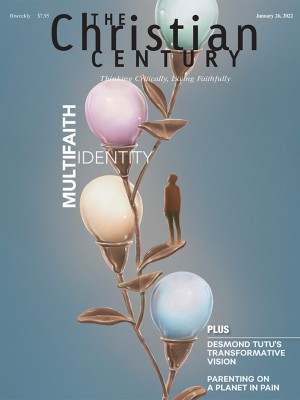February 13, Epiphany 6C (Luke 6:17–26)
Luke’s Beatitudes call us to live in the tension of a cross-shaped life.
On Thursday evenings I teach ballet class. In constructing barre exercises that help warm up the body for more intricate steps, I aim to balance the use of muscle groups. The practice of moving en croix, in the shape of the cross, creates both tension and balance in the body. Each exercise is completed with the foot tracing the shape of a cross on the floor, once to the front in fourth position, to the side in second position, and to the back, again in fourth position. The dancer stands in the center of the cross, and the limbs move to explore the space where the well-worn path of the cross leads them.
Luke’s opening to the Sermon on the Plain invites us into the tension of living a cross-shaped life. As Jesus comes down the mountain to the plain, the disciples gather to receive instruction for their new role as apostles and the crowds clamor around Jesus to see his power reflected back into their lives. Jesus sees in them all a people in need of both blessing and challenge.
Read our latest issue or browse back issues.
On first read, I often fall into the trap of reading these blessings and woes as I would a personality quiz. I want to find a comfortable place to land and find my identity. But every verse can seem to fit, so I see myself in conflicting categories. On subsequent readings, it seems Jesus cares less about sorting us out than welcoming us to live in the tension of all these experiences.
The disciples are already experiencing such a tension. Jesus has just called them to follow him. Now he adds the title of apostle to their job description: they will be sent before him, carrying the message that the in-breaking of God’s new creation is close at hand. Their paradoxical role as both those who follow behind and those who are sent ahead invites them into the tension of a cross-shaped life.
This balancing act of discipleship and apostleship echoes the balancing of blessings and woes. Each one contains its own reversal. When I am empty I will be filled, but once full I will be emptied. There is tension as one charts a path through the blessings, woes, and reversals.
Amy-Jill Levine and Ben Witherington III note how Luke’s Sermon on the Plain (6:17–49) is much shorter than Matthew’s Sermon on the Mount (5–7) and that, as concerns the Beatitudes, Luke focuses narrowly on four blessings balanced by four woes. Luke’s rhetorical balance acknowledges that the disciples and crowds listening could have found themselves in both categories simultaneously: the blessed who are comforted when experiencing physical, financial, emotional, and societal hardship and struggle and those who are convicted by the woes where their actions, known and unknown, have confused earthly riches, full bellies, laughter, and a good reputation for honest discipleship and faithful apostleship.
Living in the equal tension of Luke’s Beatitudes is to stand en croix, tracing the shape of the cross into the sacred ground beneath our feet in both confession and forgiveness. We stand in the center between receiving God’s grace and comfort in times of poverty, physical hunger, tears, and revilement and confessing the ways that we contribute to the hardship of others, place false trust in our abilities and assets, and fail to bring comfort to our neighbors. We may find ourselves stretched between both categories and living in them both simultaneously—both saint and sinner, to quote Martin Luther.
In both places, Jesus aims to remove any barriers to seeing God’s image reflected in our lives. Poverty, hunger, tears, and being hated can distort our reflection and convince us that we are less than human. Jesus brings blessing, comfort, and hope in order to restore a sense of holy createdness. Wealth, full bellies, mirth, and the esteem of others can also distort our sense of self. Jesus calls out, “Whoa!” and in that holy pause we can repent and make room for God’s presence in our lives. Jesus does not come into the world to condemn. We don’t need to fear being cancelled, only to make room for God’s love.
The path of redemption and wholeness, of blessing, is a complex journey—for us as for the disciples and crowd on the plain. We cannot focus on just one place that resonates or makes sense. A cross-shaped life demands living in the tension of honest confession of sin and the glorious reception of God’s grace.
We cannot avoid the woes, those places we’d like to ignore or imagine don’t exist. In dance, I prefer to move to the side and would gladly ignore movements to the front and back. But if I spent all my time on my favored position, I would fail to grow and to appreciate the full expression of dance. Christ invites the disciples and the crowds to live into the fullness of a God-focused life.
In Luke 6, the cross is still quite a distance away in Jesus’ ministry, but his preaching already invites listeners into the rhythms of death and resurrection. Conviction and awareness of sin and death are balanced with Jesus’ promise of new life, blessing, and hope. Ultimately, a cross-shaped life leads to love, which is where Jesus proceeds in the rest of his sermon. Loving God and loving one’s neighbor require full-bodied living that balances the receiving of blessings, the humility of repentance, and the commitment to living a life of love. We are invited to live en croix.





